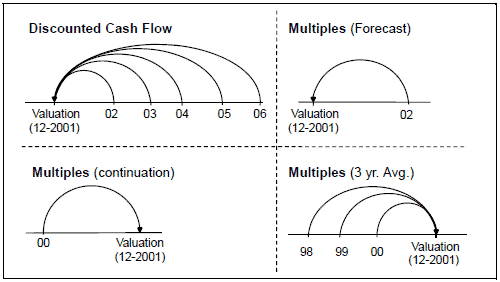Is the discounted cash flow (DCF) method or the comparables method more accurate in forecasting equity valuations? In their April 2009 preliminary paper entitled “Exploring the Accuracy of DCF and Comparables Valuation Methods by Using Ex-Post Market Data as Forecasts”, Friedrich Sommer, Arnt Woehrmann and Andreas Wömpener use both truly historical data and “best” forecasts of basic firm fundamentals (such as earnings) to compare the forecasting power of the DCF and comparables methods. They define “best” forecasts of input data as actual results inserted retroactively (see the chart below). They consider multiple variations of both the DCF and comparables methods. Using fundamentals and stock price data for the period 1998 through 2006 to support truly historical and retroactive valuation calculations as of 12/31/2001 for 89 U.S. public companies via DCF and over 200 U.S. public companies via comparables, they conclude that:
- Optimization efforts generate little improvement in forecasting power for the DCF method.
- Optimization efforts for the comparables method yields the following results:
- Three-year averages of inputs, whether truly historical or retroactively inserted future data, outperform one-year data. Truly historical data sometimes outperforms retroactively inserted future data.
- When using three years for calibration of comparables, the median significantly outperforms the arithmetic mean, and the harmonic mean outperforms both the median and the arithmetic mean.
- While basic “textbook” versions of the two methods indicate that DCF outperforms comparables, optimal versions of the comparables method outperform optimal versions of the DCF method.
The following chart, taken from the paper, depicts approaches for using truly historical and actual firm fundamentals data retroactively in various DCF and comparables models.

In summary, limited evidence suggests that investors who rely on fundamental valuation should consider using comparables (valuation multiples) based on harmonic means of several years of historical data as forecast drivers.